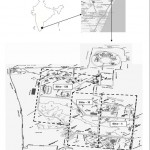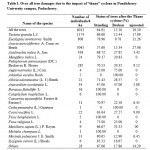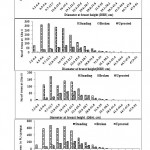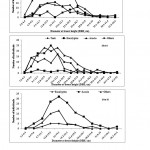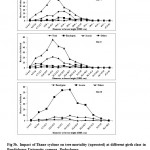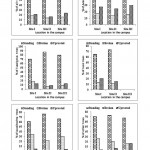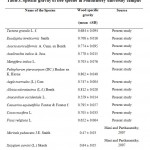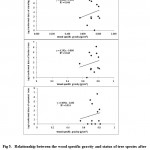Impact of Thane Cyclone on Tree Damage in Pondicherry University Campus, Puducherry, India
SM. Sundarapandian1 * , K. Mageswaran1 , D. Sanjay Gandhi1 and Javid Ahmad Dar1
1
Department of Ecology and Environmental Sciences,
Pondicherry University,
Puducherry,
605014
India
DOI: http://dx.doi.org/10.12944/CWE.9.2.09
The heavy wind along with high rainfall of the catastrophic windstorm “Thane” cyclone cause defoliation, uprooting and snapping of stems and branches of trees in Pondicherry University Campus, Puducherry. A total of 1181 (20%) trees (>3.2 cm DBH) in Pondicherry University Campus were uprooted due to the Thane cyclone. Tree mortality (uprooted) and damage (broken) were observed more in Acacia auriculiformis than other species in response to Thane cyclone in Pondicherry University campus. In the present study, wood density did not show any significant relationship between the damage, mortality and resistance (standing with defoliation and minor branch fall). Acacia auriculiformis was more susceptible to Thane cyclone followed by Tectona grandis. However, Azadirachta indica and Mangifera indica were observed more resistance to thane cyclone. The greater uprooting in introduced plantation species such as Acacia auriculiformis and Tectona grandis was higher than native species Azadirachta indica and Mangifera indica which could be attributed to spread their roots in the surface soil and they do not penetrate deeper into the soil.
Copy the following to cite this article:
Sundarapandian Sm., Mageswaran K, Gandhi D. S, Dar J. A. Impact of Thane Cyclone on Tree Damage in Pondicherry University Campus, Puducherry, India. Curr World Environ 2014;9 (2) DOI:http://dx.doi.org/10.12944/CWE.9.2.09
Copy the following to cite this URL:
Sundarapandian Sm., Mageswaran K, Gandhi D. S, Dar J. A. Impact of Thane Cyclone on Tree Damage in Pondicherry University Campus, Puducherry, India. Curr World Environ 2014;9 (2). Available from: http://www.cwejournal.org/?p=6105
Download article (pdf)
Citation Manager
Publish History
Select type of program for download
| Endnote EndNote format (Mac & Win) | |
| Reference Manager Ris format (Win only) | |
| Procite Ris format (Win only) | |
| Medlars Format | |
| RefWorks Format RefWorks format (Mac & Win) | |
| BibTex Format BibTex format (Mac & Win) |
Article Publishing History
| Received: | 2014-02-26 |
|---|---|
| Accepted: | 2014-04-25 |
Introduction
Heavy wind is known to alter the structure and functioning of forest ecosystems, agro-forestry systems and plantations. The intensity and frequency of severe wind events are likely to increase deterioration to the forests. It is important to understand the species and substrate-specific effects of these disturbances. The immediate impacts of tropical cyclones – defoliation, limb loss, snapping of stems and uprooting of trees – have profound impacts on tropical forests.1-4 These catastrophic disturbances create canopy gaps, which can cause significant changes in forest microclimates in the understory and canopy,5-9 and complex vegetation and faunal responses to newly created light, temperature and humidity regimes.10-12 The resulting altered environmental conditions can initiate other changes to the forest. The buildup of debris caused by cyclone damage is coupled with dry weather; there is a risk of fire incursion into forest.13 The increased light intensity in the forest floor due to canopy gaps can release suppressed seedlings of pioneer species/ light demanding species, which may alter floristic composition.4 Storm intensity, topographic protection and disturbance history could influence cyclone damage while certain functional traits of trees can also be important.4 Severe cyclones cause widespread defoliation of canopy trees, removal of vines and epiphytes, along with the breakage of crown stems and associated tree falls.3,4,8,14-17 Cyclonic disturbance has also been shown to accelerate invasion by exotic tree species leading to a decline in biodiversity of native species.18
Cyclones modify the structural components which include the stripping of leaves from branches and the breakage of branches, roots, and stems.19 Factors mitigating these effects include plant attributes, such as properties of wood,20 leaves and petioles,21-22 roots and buttresses,23-24 forest level physiognomy,25-27 properties of the wind event itself,28 as well as resource availability.29-30
Effects of cyclone on the structure and production of forests are often species-specific.19-20,25,28,31-33 Species may vary in their capacity to resist wind (resistance), offset the effects of injury (tolerance), and recover from injury (resilience). It is unlikely that any one taxon will display all three of these characteristics (resistance, resilience, tolerance). This is because of site- and habitat-specific resource limitations which will force a tradeoff among them.3,19
Severe wind events, including cyclones, tornadoes, typhoons and thunderstorm downbursts, occur in nearly all forest systems throughout the world. Forest composition, structure, and functioning are affected by the severity and frequency of these events. Although much information on the effects of wind have been gathered from Caribbean, North America, South American forest systems and Australian rainforests, data remain limited for the old World tropics, and in particular to south India i.e., Tamil Nadu and Pondicherry (impact of cyclones on crop damage in terms of economical return and general damage in the prospective of economy has been generated in order to provide relief fund, however scientific generation of data on damage in the ecological perspective in Tamil Nadu and Puducherry was almost nil). The earlier cyclone namely Nisha, Jall and now Thane cyclone have affected Tamil Nadu and Pondicherry. No published information of Nisha and Jall cyclones on tree species damage is available. Therefore, the data generated from the present study would be the baseline data for further comparisons and prediction of future impacts of cyclone intensities. The ‘Thane’ name was given simply by weather reporters so as to reach the people easily. Due to thane cyclone power production was affected at the Neyveli Lignite Corporation as the mines were submerged. Puducherry was cut off from the neighbouring districts of Villupuram and Cuddalore, in Tamil Nadu.34 It has caused to fell several trees across the roads due to the impact of gale. Published information on the impacts of cyclone on tree mortality and damages are not available in Tamil Nadu and Puducherry. Therefore, the present study was intended to assess the impact of severe tropical cyclone “Thane” on forest tree species damage in Pondicherry university campus, Puducherry, India. The present study would also to address the following questions: a) which tree species is suitable for raising plantation near to the tropical coastal region in the red soil conditions? b) Whether wood density provides resistance to the severe winds?
Study Area and Description
Pondicherry University (12° 0.97´ N 79° 51.33´ E), located 10 km North of Puducherry town, on the Coromandel coast of India (Figure 1). It covers an area of 780 acres. The climate is tropical dissymmetric type with most rainfall received during the northeast monsoon (October-December) and meager and inconsistent during southwest monsoon (June-September). The mean annual rainfall is 1282 mm for the last two decades (1990-2010).The dry season lasts for about six months (January-June), but there are summer showers too during this period. The mean annual maximum and minimum temperature are 32.58°C and 24.51°C for Puducherry. The soil is red-ferralitic, sandy in texture and heavily drained. Historically, the 780 acre land of Pondicherry University, in various portions, was composed of Tropical dry evergreen scrub, and palm savannas on the western and southern part of the campus, cashew plantations, rice, and sugarcane and groundnut cultivation on the eastern side. The landscape was modified over quarter century with buildings, roads, lawns and ornamentals. The varied topography of the campus such as forests, scrubs, savannas, scenic Grand Canyon-like Cuddalore sand-stone formation with lateritic cap, is responsible for high diversity in plant species. A natural area of the campus consists of tropical dry evergreen forest, dry evergreen scrub, scrub savanna and tropical thorn forest. The flora of the university campus was illustrated by Parthasarathy et al.35
|
|
Figure 1: Location of the study area, Pondicherry |
Cyclone “Thane”
“Thane” was a very severe cyclonic storm developed over Bay of Bengal during last week of December 2011. It crossed north Tamil Nadu and Puducherry coast between Puducherry and Cuddalore within 06.30 – 07.30 hrs (IST) of 30th December 2011 with a wind speed of 120 -140 km/hr.36 The Joint Typhoon Warning Center (JTWC) issued a tropical cyclone formation alert on the system during December 25 before designating as Tropical Cyclone 06B later that day as 1-minute wind speeds near the centre reached 65 km/h (40 mph) which is equivalent to a tropical storm. The India Meteorological Department (IMD) also reported during December 25 that the disturbance had organized sufficiently to be declared Depression BOB 05, while it was located about 1,000 km to the southeast of Chennai, India. Early on December 26, the IMD reported that the depression had intensified into a Deep Depression, later on it had intensified into a cyclonic storm and named as “Thane”. The JTWC reported that Thane had become equivalent to a category one hurricane on the Saffir- Simpson Hurricane Wind Scale with 1-minute sustained wind speeds of 120 km/h (75 mph) on early 26th December, while an eye feature had become visible on microwave imagery. Later IMD confirmed the same with 3-minute sustained wind speeds of 120 km/h (75 mph). Thane continued to intensify and developed a small pinhole eye of about 20 km (10 mi) on 28th December. The JTWC reported that Thane had peaked early on December 29 with 1-minute sustained wind speeds of 150 km/h (90 mph). The IMD reported that the system had peaked as a very severe cyclonic storm with 3-minute sustained wind speeds of 140 km/h (85 mph). System continued to move westwards and weakened slightly as it started to interact with land and then made landfall as a borderline during December 30 on the north Tamil Nadu coast between Cuddalore and Pondicherry. After it had made landfall, frictional forces made Thane rapidly weaken into a depression.36-37 As per JTWC best track data the Thane cyclone was a Typhoon and would be under the Typhoon Category 1 (based on relating wind speed).38
Due to cyclonic storm, sea wave were 1.5 m high. Puducherry was caused extensive damages in cyclonic storm. Rainfall was 15 cm on 30th and 10 cm on 31st December 2011.36 The Eleven number flag (Great danger- signal stated that severe cyclone to cross the cost by port official based on IMD information) was hoisted in Cuddalore and Puducherry harbor. Severe winds with heavy rainfall have damaged houses and uprooted trees. The cyclone was the severest in the history of Puducherry.34 The first time that a high intensity cyclone was hit the Union territory after the one in the 1950’s. Even in Puducherry and Cuddalore thatched huts of fishermen and wooden frames in slum areas were completely destroyed. Several trees have fallen down in private coconut plantations and cashew-nut plantations. The cyclone damage in the Pondicherry University campus was more severe i.e. several trees were uprooted and broken, damage the electric poles, bus stops and clearing the road in the campus itself took more than three days.
Methods
For the present study, entire university campus was divided in the three sub sites namely Site I (which is located near to the coastal zone within the campus, i.e. area up to 500 m from the eastern compound wall of the University campus), Site III is one km away from the eastern compound wall of the University campus and site II lies in between the site I and site III.
Cyclone effects on each tree were assessed by visually estimated or recorded uprooted and largest broken branch and standing stage in each study site in the Pondicherry University campus by quadrat method. A large number of 10 m X 10 m quadrats were laid in each site (Site I-161 quadrats; Site II-156 quadrats; Site III-93 quadrats) and noted the status of each tree and measured the girth at breast height (the values are converted to diameter at breast height (DBH)) also.
Since the trees were uprooted by the cyclone Thane, it was a good opportunity to collect the wood form the main trunk. Wood pieces of main trunk were collected from the uprooted trees and measured the green volume and then measured dry weight of the wood pieces by oven drying at 105 â°C ± 5 â°C for 72 hours. To determine wood specific gravity, tree species that are represented by ≥ 3.2 cm DBH individual in the Pondicherry University campus were considered. Wood specific gravity was determined using sample of stems (2-8 cm long and 8.9-29 cm diameter) cut at the main trunk. The volume of each sample was determined from the volume of water it displaced when submerged, according to ASTM standard norms.38 The basic specific gravity was calculated as oven-dry weight divided by volume.40-41
One Way ANOVA was used to test whether significant difference among the wood specific gravity of the tree species. Linear regression analysis was used to study the relationship between the wood specific gravity and tree damage.
Results
A total of 1181 (19.59%) trees (>3.2 cm DBH) in Pondicherry University Campus were uprooted due to the Thane cyclone (Table 1). Among the tree species distributed in the campus, Acacia auriculiformis showed highest mortality (27% uprooted) followed by Tectona grandis (18%) and Eucalyptus tereticornis (11%). Snapped trees (part of the tree broken) in the university campus due to Thane cyclone were 929 (15.5%). Among the six dominant tree species Azadirachta indica showed higher (28%) rate of damage due to snapped off (branch fall) followed by Mangifera indica and Peltophorum pterocarpum. However, the predominant species, Acacia auriculiformis, Tectona grandis and Eucalyptus tereticornis in the campus showed less damage in term of snapped off compared to other species. Tree species standing with minor damage and defoliation were more than 58% of the total population except for Ailanthus excelsa and Anacardium occidentale.
|
|
Table 1: Over all tree damages due to |
Maximum number of mortality (uprooted) and snapped off (broken) trees observed in size classes between 9.7 - 22.3 cm DBH in all the study sites and also in the entire campus pooled data (Fig. 2). However, cyclone has caused damages on all size classes of tree species. Impact of Thane cyclone on various size classes of trees is presented in the Figure 3a&3b. In Acacia auriculiformis, maximum tree mortality (uprooting) were observed in the size class in between 9.8 – 28.7 cm DBH in all the study sites while snapped off (broken) were observed in the size class in between 6.5 – 25.5 cm DBH. A similar trend was occurred in Tectona grandis and other species in all the study sites except in the other species mortality (uprooted) in site III. However, cyclone damage on Eucalyptus trees did not show any specific trend in size classes.
|
|
Figure 2: Trees size classes wise status after |
|
|
Figure 3(a): Impact of Thane cyclone on tree |
|
|
Figure 3(b): Impact of Thane cyclone on tree |
Cyclone damage on all trees were greater in site I and site III compared to site II (Fig. 4). Cyclone resulted in greater mortality in both site I and site III than that of site II whereas snapped off (broken) was observed more in the site I than that of other study sites. A similar trend was observed on Acacia and Eucalyptus tree species. However, in Tectona grandis and Azadirachta indica, grater damage was observed in site I than that of site II.
|
|
Figure 4: Impact of “Thane” Cyclone on tree |
|
|
Table 3: Specific gravity of tree species |
Wood specific gravity estimated in the present study was ranged 0.559 to 0.812 g/cm3 (Table 3). Maximum wood specific gravity was obtained in Albizia odoratissima followed by Peltophorum pterocarpum, Azadirachta indica and Acacia auriculiformis. However, the least was Anacardium occidentale. One way ANOVA analysis indicates that there is a significant difference found among the trees in the present study with respect to the wood specific gravity (F-value: 5.27; P >0.001) among the trees in the present study. Regression analysis indicates that there is no significant relationship in between the wood specific gravity and cyclone damage of trees (uprooting and broken) in Fig.5.
|
|
Figure 5: Relationship between the wood specific gravity |
Discussion
The heavy wind along with high rainfall of the catastrophic windstorm “Thane cyclone” have caused defoliation, uprooting and snapping of branches of trees in its path of Puducherry and Cuddalore district of Tamil Nadu as like that of earlier studies done elsewhere,1,2,15,42 either by direct wind damage (wind-throw or defoliation), or indirect effects of wind (large trees and branches damaging small trees.43 In the present study the medium sized adult trees (6.5 – 22.3 cm DBH) were damaged due to heavy wind of Thane cyclone. Similarly medium sized trees were damaged due to heavy wind in Kolombangara.44 In contrast, forests in Texas and Puerto Rico suffered higher mortality rates among larger diameter trees of some species.2,45 Tree size (DBH) did not confer any increased or decreased resistance to damage from cyclone Thane in Pondicherry University Campus among tree species. Similarly, no specific relationship was obtained by Curran et al.46 from cyclone Larry among Mabi forest trees when tree size-classes and damage categories used for analysis. These results are unexpected, as several studies have found that larger trees experience greater wind damage,47-50 although such findings are not universal20 and tree size did not influence mortality in Jamaica.3 Everham and Brokaw4 have reviewed many studies of wind damage to forest vegetation. They have suggested that lack of consistent trends between tree size and damage across studies could be attributed to such factors as variation occurred between the species and within the species regarding the relationship between tree height (which is more directly related to wind exposure) and diameter, as well as different measures of damage and different size-classes used by researchers. Furthermore, Everham and Brokaw4 propose that traits such as crown size may give more accurate estimations of resistance. Preliminary studies on common Mabi forest species showed some relationships between damage and mean canopy spread.46 The present study shows maximum uprooting in Acacia trees compared to teak and Eucalyptus. This may be attributed to height and canopy spread because Acacia tree have greater height than that of the teak as well as greater canopy spread compared to Eucalyptus trees.
Twenty presentage (1181) of trees were uprooted in Pondicherry University Campus due to Thane cyclone. This value is grater to overall mortality on plots of subtropical wet forest in Puerto Rico following hurricane Hugo48 and in lower montane rain forest in Jamaica in response to hurricane Gilbert,51-52 although it is within the range for catastrophic windstorms.4
Tree mortality (uprooted) and damage (broken) in Pondicherry University campus showed that the greater values in individuals of Acacia auriculiformis are more than that of other species in response to Thane cyclone. Other studies have also shown differences between tree species in susceptibility to death or damage during severe windstorms.14,25,42,53 These differences may be linked to wood properties2,47 or tree architecture.25
Wood density appears to be a trait fundamental to cyclone resistance.54 However, in the present study, wood density did not show any significant relationship between the damage (broken) and mortality (uprooted). Similarly, no relationship was found between resistance and wood density in Jamaican forest,3 Hawaiian forests,20 nor across a variety of forest types in north Queensland following Cyclone Larry.50 However, relationships between wood density and wind resistance have been found in a number of forest types and environments, including: tropical moist forest at Barro Colorado Island,47 subtropical wet forest in Puerto Rico2 and tropical rainforest in north Queensland.54 Metcalfe et al.50 based their assertion on the observations viewed that some tree species with different wood density experienced similar types of damage, while others with similar wood density experienced different levels of damage relative to other sympatric species. Similarly, in the present study tree species with closure wood density showed different response to Thane cyclone.
Leaf traits could also determine levels of damage in the context of cyclone resistance.46 In the present study, leaf traits may also be induced the effect of Thane cyclone on tree mortality (uprooted) in case of Tectona grandis, Eucalyptus tereticornis and Acacia auriculiformis compared to other tree species. Similarly, leaf size (such as area, length or width) and petiole length could influence defoliation by altering the drag forces experienced during a windstorm.21 The same may be true of traits related to leaf strength. For instance, specific leaf area (SLA) (one-sided area divided by dry mass,55 55 Westoby 1998) is a good, readily measured attribute for leaf strength, owing to its negative correlation with leaf force to fracture and leaf toughness (force to fracture/leaf thickness)56 which determine the level of damage during cyclone resistance.
Physical damage from a tropical cyclone might be greatest at edges of the forest or in small fragments that have a high proportion of edge.57 Similarly, the forest distance from the coastal zone is an important trait to determine the impacts of cyclone. Damage of trees due to Thane cyclone were greater in site I compared to site II and site III. The variation in damage among the study sites could be attributed to distance from coastal zone. However, site III had greater mortality of trees compared to that of site I and II even though this site was for away from the coastal zone. This may be due to greater density of trees per unit area which is mostly in an open space. The study site I that has lesser mortality because heavy wind force at few meter height is reduced by compound wall of the university campus. However, broken (snapped of branches) were greater in study site I because part of canopy of trees in site I is exposed to heavy cyclone wind. In study site II, several buildings are located which may reduce wind speed or alter or change the wind directions. This could be the reason for less damage in site II compared to site I and site III. It is likely that the high wind intensity from severe tropical cyclones overrides the modest wind protection provided by surrounding forest. Similarly, the results of the present study also indicate that the tree damage effects of cyclone are patchy at local scale of 0.05 km. The main effect of cyclone Larry at forests was to increase the spatial heterogeneity of forest structure at local scales.57 The cyclone’s effects were highly patchy at local scales (0.5–1.0 km), leading to an increase in among-site variation in forest structure and the disappearance of significant spatial autocorrelation among large remnant edge-interior site pairs which had existed prior to the cyclone.57
The present study reveals that the Thane cyclone has caused high rates of defoliation, uprooting and snapped off stems and branches to trees in their path particularly in Pondicherry University campus, Puducherry, India. Acacia auriculiformis was more susceptible to Thane cyclone followed by Tectona grandis. However, Azadirachta indica and Mangifera indica were more resistance to thane cyclone. This could be attributed to the roots of all introduced species which do not penetrate deeper into the hard red soil. Instead they spread their roots as reported by Narasimhan and Oppili.58
Acknowledgement
We thank anonymous reviewer for their valuable comments and suggestion on the manuscript. We also thank Dr. A. Munian, Department of linguistics, Madurai Kamaraj University for language corrections.
References
-
Unwin G.L., Applegate G.B. and Stocker G.C., Initial effects of tropical cyclone ‘Winifred’ on forests in north Queensland. Proceed. Ecological Society of Australia 15: 283–96 (1988).
-
Zimmerman J.K., Everham E.M. III, Waide R.B., Lodge D.J., Taylor C.M. and Brokaw N.V. L., Responses of tree species to hurricane winds in subtropical wet forest in Puerto Rico: implications for tropical tree life histories. Journal of Ecology 82: 911–22 (1994).
-
Bellingham P. J., Tanner E.V. J. and Healey J. R., Damage and responsiveness of Jamaican montane tree species after disturbance by a hurricane. Ecology 76: 2562–80 (1995).
-
Everham E.M. III and Brokaw N.V.L.,. Forest damage and recovery from catastrophic wind. Botanical Review 62: 113–85 (1996).
-
Fernandez D.S. and Fetcher N., Changes in light availability following Hurricane Hugo in a subtropical montane forest in Puerto Rico. Biotropica 23: 393–9 (1991).
-
Turton S.M., Understory light environments in a northeast Australian rain forest before and after a tropical cyclone. Journal of Tropical Ecology 8: 241–52 (1992).
-
Bellingham P. J., Kohyama T. and Aiba S. , The effects of a typhoon on Japanese warm temperate rainforests. Ecological Research 11: 229–47 (1996).
-
Lugo A.E. and Scatena F.N., Back ground and catastrophic tree mortality in tropical moist, wet and rain forests. Biotropica 28: 585–99 (1996).
-
Turton S.M. and Siegenthaler D.T., Immediate impacts of a severe tropical cyclone on the microclimate of a rain-forest canopy in north-east Australia. Journal of Tropical Ecology 20: 583–586 (2004).
-
Bellingham P.J., Tanner E.V.J. and Healey J.R., Sprouting of trees in Jamaican montane forests after a hurricane. Journal of Ecology 82: 747–58 (1994).
-
Vandermeer J., Mallona M.A., Boucher D., Yih K. and Perfecto I., Three years of in growth following catastrophic hurricane damage on the Caribbean coast of Nicaragua: evidence in support of the direct regeneration hypothesis. Journal of Tropical Ecology 11: 465–71 (1995).
-
Harrington R.A., Fownes J.H., Scowcroft P.G. and Vann C.S., Impact of Hurricane Iniki on native Hawaii an Acacia koa forests: damage and two-year recovery. Journal of Tropical Ecology 13: 539–558 (1997).
-
Webb L. J.,Cyclones as an ecological factor in tropical lowland forest, north Queensland. Australian Journal of Botany 6: 220–228 (1958).
-
Lugo A.E., Appleï¬eld M., Pool D.J. and Mcdonald R.B., The impact of Hurricane David on the forests of Dominica. Canadian Journal of Forest Research 13: 201–11 (1983).
-
Brokaw N.V. L. and Walker L. R., Summary of the effects of Caribbean hurricanes on vegetation. Biotropica 23: 442–7 (1991).
-
Tanner E.V.J., Kapos V. and Healey J.R., Hurricane effects on forest ecosystems in the Caribbean. Biotropica 23: 513– 21 (1991).
-
Boose E.R., Foster D.R. and Fluet M., Hurricane impacts to tropical and temperate forest landscapes. Ecological Monograph 64: 369–400 (1994).
-
Bellingham P. J., Tanner E.V. J. and Healey J. R., Hurricane disturbance accelerates invasion by the alien tree Pittosporum undulatum in Jamaican Mountain rain forests. Journal of Vegetation Science 16: 675–84 (2005).
-
Gleason, S.M., Williams, L.J., Read, J., Metcalfe. D.J. and Baker, P.J., Cyclone Effects on the Structure and Production of a Tropical Upland Rainforest: Implications for Life-History Trade-offs. Ecosystems 11: 1277–1290. (2008)
-
Asner G. P. and Goldstein G., Correlating stem biomechanical properties of Hawaii an canopy trees with hurricane wind damage. Biotropica 29: 145–50 (1997).
-
Niklas K.J., A mechanical perspective on foliage leaf form and function. New Phytology 143: 19–31 (1999).
-
Cordero RA, Fetcher N. and Voltzow J., Effects of wind on the allometry of two species of plants in an elï¬n cloud forest. Biotropica, 39: 177–85 (2007).
-
Fraser A.I., The soil and roots as factors in tree stability. Forestry 35: 117–27 (1962).
-
Stokes A., Strain distribution during anchorage failure of PinuspinasterAit. at different ages and tree growth response to wind-induced root movement. Plant and Soil 217: 17–27 (1999).
-
Foster D.R., Species and stand response to catastrophic wind in central New England, USA. Journal of Ecology 76: 135–51 (1988).
-
Foster D.R. and Boose E.R., Patterns of forest damage resulting from catastrophic wind in central New England, USA. Journal of Ecology 80: 79–98 (1992).
-
Cooper-Ellis S., Foster D.R., Carlton G. and Lezberg A., Forest response to catastrophic wind: results from an experimental hurricane. Ecology 80: 2683–96 (1999).
-
Canham C.D., Papaik M.J. and Latty E.F., Interspeciï¬c variations in susceptibility to wind throw as a function of tree size and storm severity for northern temperate tree species. Canadian Journal of Forest Research 31: 1–10 (2001).
-
Herbert D.A., Fownes J.H. and Vitousek P.M., Hurricane damage to a Hawaiian forest: nutrient supply rate affects resistance and resilience. Ecology 80: 908–920 (1999).
-
Beard K.H., Vogt K.A., Vogt D.J., Scatena F.N., Covich A., Sigurdardottir R., Siccama T.C. and Crowl T.A., Structural and functional responses of a subtropical forest to 10 years of hurricanes and droughts. Ecological Monograph 75(3): 345-361 (2005).
-
Gresham C.A, Williams T. M. and Lipscomb D.J., Hurricane Hugo wind damage to southeastern U.S. coastal forest tree species. Biotropica 23: 420–426 (1991).
-
Bellingham, P.J., Cyclone Effects on Australian Rain Forests: An Overview. Austral Ecology 33: 580–584 (2008).
-
Cook, G. D. and Goyens C.M. A. C., The Impact Of Wind On Trees In Australian Tropical Savannas: Lessons From Cyclone Monica. Austral Ecology 33: 462–470 (2008).
-
Punithavathi J., Tamilenthi S. and Baskaran R., A study of thane cyclone and its impacts in Tamil Nadu, India using geographic information system. Scholar of Research Library 4(1): 685-695 (2012).
-
Parthasarathy N., Arulpragasan L., Muthumperumal C. and Anbarasan M., Flora of Pondicherry University campus. Pondicherry University, Puducherry, 1-377 (2010).
-
IMD., Very severe cyclonic storm “Thane” over the Bay of Bengal (25-31 December 2011: A report. MES, Government of India, Cyclone Warning Division, New Delhi. www.imd.gov.in/section/nhac/dynamic/THANE.pdf (2012).
-
JTWC.,http://www.usno.navy.mil/NOOC/nmfc-ph/RSS/jtwc/best_tracks/ioindex.html (2013).
-
Guard, C.C. and Lander, M.A., A scale relating tropical cyclone wind speed to potential damage for the tropical Pacific Ocean region: A user’s manual. Weri technical report 86. National weather Service Pacific region Headquarters.1-5 pp (1999).
-
ASTM., Standard test methods for specific gravity of wood and wood based materials. American Society for Testing and Materials D 2395083.1986.353-359 (1986).
-
Cordero, L.D.P. and Kanninen M.N., Wood specific gravity and above ground biomass of Bombacopsis quinata plantations in Costa Rica. Forest Ecology and Management 165: 1-9 (2002).
-
Mani S. and Parthasarathy N. Above ground biomass estimation in ten tropical dry evergreen forest sites of peninsular India. Biomass and Bioenergy 3: 284-290 (2007).
-
Wadsworth F.H. and Englerth G.H., Effects of the 1956 hurricane on forests in Puerto Rico. Caribbean Forestry 20: 38-51(1959).
-
Frangi J.L. and Lugo A.E., Hurricane damage to a flood plain forest in the Luquillo Mountains of Puerto Rico. Biotropica 23: 324–35 (1991).
-
Whitmore T. C., Change with time and the role of cyclones in tropical rain forest on Kolombangara, Solomon Islands. Commonwealth Forest Institute Paper 46: Oxford (1974).
-
Glitzenstein J.S. and Harcombe P.A., Effects of the December 1983 tornado on forest vegetation of the Big Thicket, Southeast Texas, U.S.A. Forest Ecology and Management 25: 269-290 (1988).
-
Curran T.J., Brown R.L. and Edwards E., Plant functional traits explain interspeciï¬c differences in immediate cyclone damage to trees of an endangered rainforest community in north Queensland. Austral Ecology 33: 451–461 (2008a).
-
Putz F.E., Coley P.D., Lu K., Montalvo A. and Aiello A., Uprooting and snapping of trees: structural determinants and ecological consequences. Canadian Journal of Forest Research 13: 1011–21 (1983).
-
Walker L.R., Tree damage and recovery from Hurricane Hugo in Luquillo Experimental Forest, Puerto Rico. Biotropica 23: 379–85 (1991).
-
Franklin J., Drake D.R., McConkey K.R., Tonga F. and Smith L. B., The effects of Cyclone Waka on the structure of lowland tropical rainforest in Vava’u, Tonga. Journal of Tropical Ecology 20: 409–20 (2004).
-
Metcalfe D.J., Bradford M.G. and Ford A.J., Cyclone damage to tropical rain forests: species- and community level responses. Austral Ecology 33: 432–41 (2008).
-
Bellingham P. J., Landforms influence patterns of hurricane damage: evidence from Jamaican montane forests. Biotropica 23: 427–33 (1991).
-
Bellingham, P.J., Kapos V., Varty N., Healey J.R., Tanner E.V.J, Kelly D.L, Dalling J.W., Burns L.S., Lee D. and Sidrak G., Hurricanes need not cause high mortality: the effects of Hurricane Gilbert on forests in Jamaica. Journal of Tropical Ecology 8: 217–23 (1992).
-
Basnet K., Likens G.E., Scatena F.N. and Lugo A.E., Hurricane Hugo: damage to a tropical rain forest in Puerto Rico. Journal of Tropical Ecology 8: 47-55 (1992).
-
Curran T.J., Gersbach L.N., Edwards W. and Akrockenberger A.K., Wood density predicts plant damage and vegetative recovery rates caused by cyclone disturbance in tropical rainforest tree species of north Queensland, Australia. Austral Ecology 33: 442–450 (2008b).
-
Westoby M., A leaf-height-seed (LHS) plant ecology strategy scheme. Plant and Soil 199: 213–227 (1998).
-
Wright I.J. and Cannon K., Relationship between leaf lifespan and structural differences in a low nutrient sclerophyll flora. Functional Ecology 15: 351–9 (2001).
-
Grimbacher P.S., Catterall C.P. and Stork N.E., Do Edge Effects Increase The Susceptibility Of Rainforest Fragments To Structural Damage Resulting From A Severe Tropical Cyclone? Austral Ecology 33: 525–531 (2008).
-
Narasimhan D. and Oppili P., Native tree species can with sand calamities. The Hindu, February, 19 (2012).


